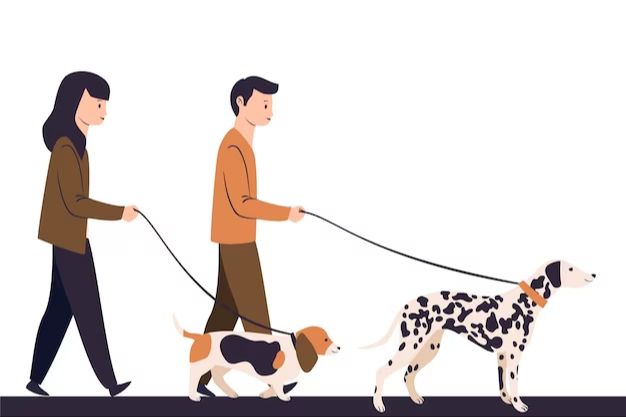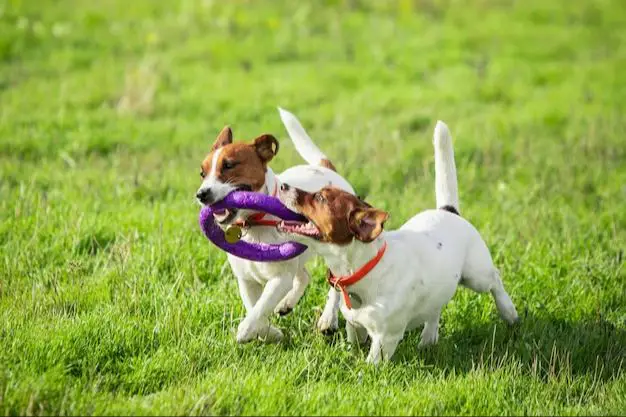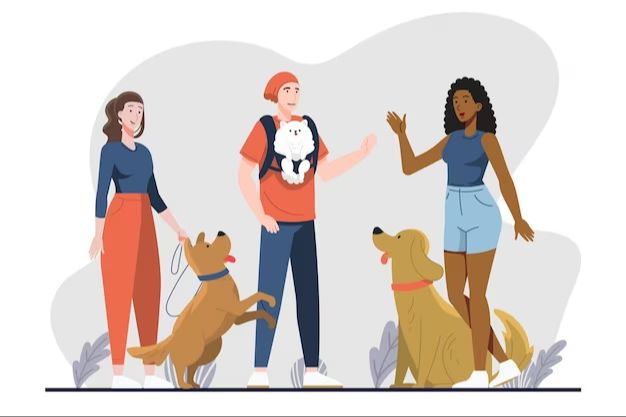Introduction
Dogs have been mankind’s best friend for thousands of years. From working dogs herding livestock to beloved pets curling up by the fire, dogs hold a special place in many people’s hearts. Their loyalty, intelligence, and trainability have made them one of the most popular domestic animals worldwide. Dogs come in countless breeds, sizes, coats, colors, and personalities. Yet no matter their differences, they all share common traits that endear them to humans – their enthusiastic greetings, sloppy kisses, and tail wagging joy at simply being near their human companions. This article explores the many facets of dogs, from their ancient ties with humans to tips on choosing and caring for a canine companion. Prepare for a fun journey into the wonderful world of dogs!
Brief History of Dogs
Dogs trace their origins back tens of thousands of years ago when they began evolving from ancient wolves. While the exact details are debated, it is believed that the first dogs arose when certain wolves began lingering around human camps for food scraps. Over time, these wolves became more comfortable around humans, and humans welcomed and encouraged the presence of the wolves, establishing a symbiotic relationship.
As this relationship developed over generations, the wolves evolved into more docile, tamer versions that were well-suited for companionship and work duties alongside humans. Through selective breeding and domestication, ancient people shaped the evolution of wolves into dogs tailored for particular jobs like hunting, guarding, and herding.
Archaeological evidence suggests dogs were domesticated by humans as early as 30,000 years ago. Canine remains and depictions found in sites around the world indicate widespread coexistence and partnership between people and dogs thousands of years ago. Dogs became an integral part of many human societies, providing protection, companionship, and aid in daily tasks.
Over the millennia since, humans have bred dogs into the incredibly diverse array of breeds we know today. From toy breeds to massive mastiffs, the domestic dog demonstrates the long shared history between our species. Dogs continue to play important roles in human society while also being beloved pets and companions.
Common Dog Breeds
Some of the most popular dog breeds kept as pets include:
Labrador Retriever – Labrador Retrievers are one of the most popular breeds in the US and UK. They are friendly, energetic, and make great family pets. Labs come in three colors – yellow, black, and chocolate. They are intelligent dogs that are easy to train.
Golden Retriever – Golden Retrievers are friendly, loyal dogs that are often used as guide dogs and therapy dogs. They are energetic and playful. Goldens have soft mouths that make them great retrievers for hunters. Their long golden-colored fur requires regular grooming.
German Shepherd – German Shepherds are highly intelligent, strong, and often used as police and military dogs. They are loyal, confident, and make excellent guard dogs. German Shepherds have a double-layered coat that sheds year-round and requires frequent brushing.
French Bulldog – French Bulldogs are a small breed with a muscular build and signature “bat ears.” They are playful, affectionate companion dogs that get along well with children. Frenchies don’t require much exercise. Their short, fine coat needs occasional brushing.
Beagle – Beagles are energetic hound dogs bred for hunting rabbits and hares. They are friendly and enjoy children. Their short coat comes in a tricolor (black, tan, white) pattern. Beagles are curious and have a tendency to follow scents.
Training Dogs

Training a dog is an important part of being a responsible dog owner. Proper training establishes expectations and allows dogs to be well-behaved members of a household. There are several effective methods for training dogs:
Positive Reinforcement – This method rewards desired behaviors with treats, praise, toys or play. When a dog exhibits good behavior, a reward is immediately given to reinforce it. This builds an association between the behavior and the reward.
Clicker Training – The clicker is a small device that makes a clicking sound when activated. It’s used to precisely mark desired actions completed by the dog. The click is followed by a reward. The clicker bridges the time between action and reward.
Lure Training – This involves using a treat or toy to lure the dog into performing a desired behavior like sit or down. The lure guides them into position, then reward is given. The lure is gradually phased out over time.
Modeling – Also called mirror training or puppet training. Trainers physically manipulate the dog’s body into the proper position for commands like sit, stay or down. Then they are rewarded in the completed position.
Shaping – Dogs are rewarded for incremental steps toward the goal behavior. For example, rewarding a puppy for orienting their body toward the sit position. Shaping builds behaviors through many approximations.
Patience, consistency and positive methods are key for successfully training dogs. Punishment or force-based methods should be avoided as they undermine trust and worsen behavior issues. Training is an ongoing process that deepens the bond between owner and dog.
Dog Behavior
Dogs exhibit a wide range of behaviors that allow them to communicate and interact with their human owners as well as other dogs. Understanding common dog behaviors provides critical insight into a dog’s mental and physical state.
Dogs primarily communicate through body language and vocalizations. Some common dog behaviors indicating happiness or contentment include tail wagging, panting with an open mouth, relaxed ears, and exposing their belly for rubs. Behaviors indicating fear, anxiety or aggression can include a tucked tail, bared teeth, growling, raised hackles, and excessive barking or howling.
Dogs that are well-socialized are friendly and playful with new people and animals. Poorly socialized dogs may be fearful or reactive towards strangers or other dogs. Puppies go through important socialization periods early in life to learn how to properly interact with people and environments.
Chewing, digging, and barking are normal dog behaviors that owners must properly direct through training and providing appropriate outlets. Providing adequate physical and mental exercise is key to preventing undesirable behaviors caused by boredom or excess energy.
Understanding a dog’s typical methods of communication allows owners to better meet their dog’s needs and build a strong human-canine bond.
Dog Care
Properly caring for a dog requires paying attention to their daily needs for food, exercise, and grooming. Each of these aspects of care helps keep dogs happy and healthy.
Feeding
Dogs should be fed a nutritious diet suited to their age, size, and activity level. Most experts recommend feeding adult dogs two meals per day and following portion guidelines on the dog food packaging based on your dog’s weight. Puppies often need to eat more frequently. Provide your dog fresh water at all times. Consult your veterinarian if you have questions about your dog’s dietary needs.
Exercise
Dogs need daily exercise to stay physically and mentally healthy. Take your dog for walks and play fetch or tug-of-war regularly. The amount of exercise depends on factors like the breed, age, and health of your dog. High energy breeds typically need more daily activity. Providing toys and puzzles can also stimulate your dog when playtime is not possible.

Grooming
Regular grooming helps keep your dog clean, free of mats, and looking their best. Brush and bathe your dog as needed for their coat type. Trim nails about once a month to prevent overgrowth and injury. Check and clean ears weekly. Brush teeth frequently with dog toothpaste. Professional groomers can help with haircuts, shampooing, and other grooming needs.
Health and Medical Needs
Ensuring your dog’s health and wellbeing means being aware of common health issues and providing regular veterinary care. Some of the most common health problems dog owners may encounter include:
Obesity – Excess weight puts strain on a dog’s joints and internal organs. Maintain a healthy weight through proper diet and exercise.
Dental disease – Bacteria in plaque and tartar buildup can lead to infection. Brush your dog’s teeth and provide dental chews.
Allergies – Dogs can develop environmental or food allergies leading to skin irritation and itching. Manage allergies through diet, bathing, and medication if needed.
Arthritis – Joint inflammation causes stiffness and pain. Manage arthritis through weight control, joint supplements, medication, and low-impact exercise.
Regular vet visits allow early detection and treatment of health issues. Puppies should start vet visits at 8-12 weeks old, followed by annual exams and vaccinations. Senior dogs may need biannual vet visits. Discuss an exam schedule with your vet based on your dog’s needs and breed risks.
Dogs and Humans
The bond between dogs and humans is unique and special. Dogs have lived alongside people for thousands of years, and this close relationship has profoundly impacted both species.

Dogs were one of the first animals domesticated by humans, with evidence of this relationship dating back over 14,000 years. Early dogs likely provided protection, assisted in hunting, and helped with various tasks. Over time, as the bond between humans and dogs grew, dogs began to take on new roles as companions, service animals, and therapy pets.
Today, dogs remain a beloved part of family life in many households. Their loyalty, affection, and playfulness continue to delight people of all ages. Interacting with dogs has been shown to reduce stress, lower blood pressure, and boost moods. The emotional support dogs provide is invaluable to many.
The deep connection between humans and dogs also continues to influence evolution. Dogs have developed specialized skills and traits to better communicate with people. Their capacity for understanding human cues and emotions is exceptional in the animal kingdom. Humans in turn have nurtured dogs into the diverse breeds we see today.
Without a doubt, the relationship between humans and dogs is a mutually beneficial partnership that has stood the test of time. This extraordinary bond looks sure to endure for many years to come.
Choosing a Dog
When choosing a dog, there are many important factors to consider so you can find the right match. Take time to reflect on your lifestyle, living situation, experience with dogs, and preferences to determine the best type of dog for you. Here are some key factors to think about:
Your Lifestyle
Consider your daily routine, habits, work schedule, activity level, and free time. An active lifestyle may suit a high-energy dog breed, while more sedentary people may prefer a low-energy lap dog. Ensure you can provide adequate exercise, enrichment, and attention for the dog’s needs.
Living Situation
Assess where and how you live – house, apartment, yard, neighborhood. Some dogs fare better in large homes or with access to a yard. Apartment dwellers may need a smaller, quieter dog. The environment should suit the dog’s size, energy, and temperament.
Experience Level
First-time dog owners need a breed that is easier to train and handle. If you’ve raised dogs before, you may opt for a breed with more complex needs. Consider your knowledge level when selecting a dog.
Age, Size, Energy Level
Do you want a puppy, adult, or senior dog? Think about the full-grown size and ideal energy level. Also factor in exercise needs, living space, and your ability to keep up with an energetic dog.
Allergies and Care Needs
If you have allergies, avoid breeds that shed a lot. Be realistic about time for grooming. Are you able to provide regular care for the dog’s needs?
Temperament

Consider your lifestyle and personality – outgoing or homebody, affectionate, playful, calm. Seek a dog with a complementary temperament that fits well with you.
Taking the time to reflect on these factors will help guide you to finding the ideal dog for your home and family!
Conclusion
In conclusion, dogs make for wonderful companions and pets. They come in all shapes and sizes, each breed with their own unique characteristics and temperaments. With proper training, socialization, exercise, nutrition and medical care, dogs can live happy and fulfilled lives while bringing great joy to their human families. Their loyalty, unconditional love and eagerness to please have earned them the title of “man’s best friend.” While choosing the right dog breed and preparing to welcome a new canine member to your home takes some research and planning, the rewards of dog ownership are immeasurable. Dogs truly enrich our lives in so many ways. If you’re considering getting a dog, take the time to carefully consider which breed suits your lifestyle and needs. With a little preparation and understanding of dog behavior and care requirements, you’ll be rewarded with years of companionship and memories with your furry best friend.